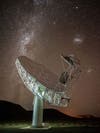Nature generates more data than the internet … for now
In the next century, the information transmitted over the internet might eclipse the information shared between Earth's most abundant lifeforms.

Is Earth primarily a planet of life, a world stewarded by the animals, plants, bacteria, and everything else that lives here? Or, is it a planet dominated by human creations? Certainly, we’ve reshaped our home in many ways—from pumping greenhouse gases into the atmosphere to literally redrawing coastlines. But by one measure, biology wins without a contest.
In an opinion piece published in the journal Life on August 31, astronomers and astrobiologists estimated the amount of information transmitted by a massive class of organisms and technology for communication. Their results are clear: Earth’s biosphere churns out far more information than the internet has in its 30-year history. “This indicates that, for all the rapid progress achieved by humans, nature is still far more remarkable in terms of its complexity,” says Manasvi Lingam, an astrobiologist at the Florida Institute of Technology and one of the paper’s authors.
[Related: Inside the lab that’s growing mushroom computers]
But that could change in the very near future. Lingam and his colleagues say that, if the internet keeps growing at its current voracious rate, it will eclipse the data that comes out of the biosphere in less than a century. This could help us hone our search for intelligent life on other planets by telling us what type of information we should seek.
To represent information from technology, the authors focused on the amount of data transferred through the internet, which far outweighs any other form of human communication. Each second, the internet carries about 40 terabytes of information. They then compared it to the volume of information flowing through Earth’s biosphere. We might not think of the natural world as a realm of big data, but living things have their own ways of communicating. “To my way of thought, one of the reasons—although not the only one—underpinning the complexity of the biosphere is the massive amount of information flow associated with it,” Lingam says.
Bird calls, whale song, and pheromones are all forms of communication, to be sure. But Lingam and his colleagues focused on the information that individual cells transmit—often in the form of molecules that other cells pick up and respond accordingly, such as producing particular proteins. The authors specifically focused on the 100 octillion single-celled prokaryotes that make up the majority of our planet’s biomass.
“That is fairly representative of most life on Earth,” says Andrew Rushby, an astrobiologist at Birkbeck, University of London, who was not an author of the paper. “Just a green slime clinging to the surface of the planet. With a couple of primates running around on it, occasionally.”

As all of Earth’s prokaryotes signal to each other, according to the authors’ estimate, they generate around a billion times as much data as our technology. But human progress is rapid: According to one estimate, the internet is growing by around 26 percent every year. Under the bold assumption that both these rates hold steady for decades to come, the authors stated its size will continue to balloon until it dwarfs the biosphere in around 90 years’ time, sometime in the early 22nd century.
[Related on PopSci+: Inside the search for the best way to save humanity’s data]
What, then, does a world where we create more information than nature actually look like? It’s hard to predict for certain. The 2110s version of Earth may be as strange to us as the present Earth would seem to a person from the 1930s. That said, picture alien astronomers in another star system carefully monitoring our planet. Rather than glimpsing a planet teeming with natural life, their first impressions of Earth might be a torrent of digital data.
Now, picture the reverse. For decades, scientists and military experts have sought out signatures of extraterrestrials in whatever form it may take. Astronomers have traditionally focused on the energy that a civilization of intelligent life might use—but earlier this year, one group crunched the numbers to determine if aliens in a nearby star system could pick up the leakage from mobile phone towers. (The answer is probably not, at least with LTE networks and technology like today’s radio telescopes.)

On the flip side, we don’t totally have the observational capabilities to home in on extraterrestrial life yet. “I don’t think there’s any way that we could detect the kind of predictions and findings that [Lingam and his coauthors] have quantified here,” Rushby says. “How can we remotely determine this kind of information capacity, or this information transfer rate? We’re probably not at the stage where we could do that.”
But Rushby thinks the study is an interesting next step in a trend. Astrobiologists—certainly those searching for extraterrestrial life—are increasingly thinking about the types and volume of information that different forms of life carries. “There does seem to be this information ‘revolution,’” he says, “where we’re thinking about life in a slightly different way.” In the end, we might learn that there’s more harmony between the communication networks nature has built and computers.
